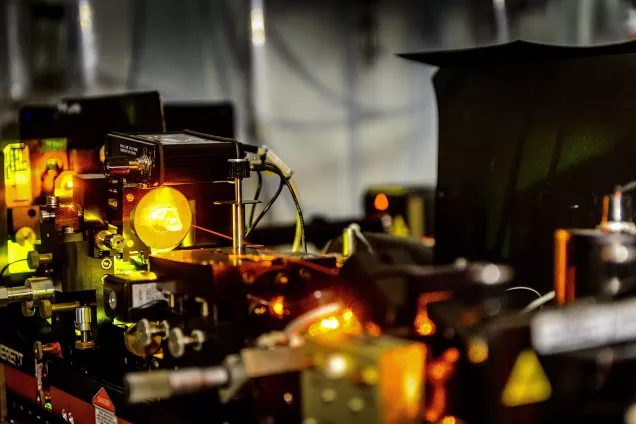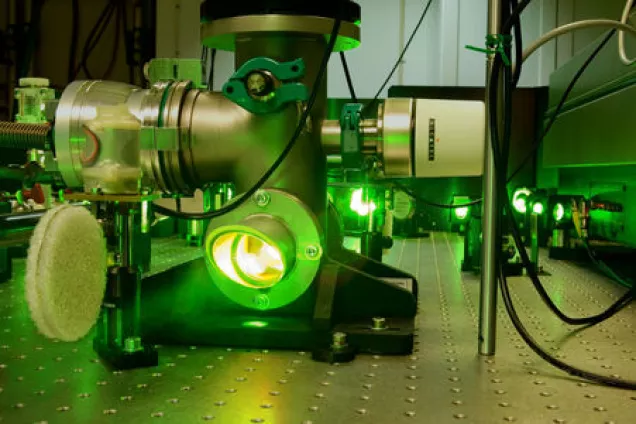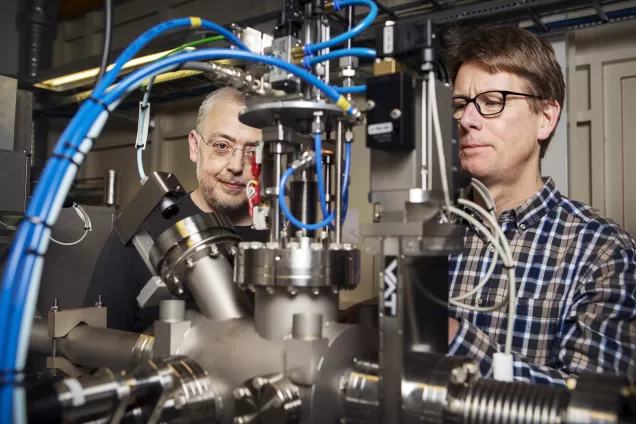Nobel Prize
Nobel Prize in physics 2023
Anne L'Huillier made a groundbreaking discovery in 1987. By transmitting infrared laser light through a noble gas, she was able to see a large number of what are known as harmonics of light. These were caused by an interaction between the laser light and the atoms in the gas. This gave certain electrons extra energy, which they then emitted as light.
First steps towards a revolutionary technology
What began as pure curiosity and a determination to explore the phenomenon soon developed into something that would change the world of physics. Anne L'Huillier and other researchers saw the possibility that these harmonics could be extremely short pulses of light – attosecond pulses. This idea was in stark contrast to what others thought was possible at the time, namely that it would not be possible to create such extremely short pulses. Yet her intuition drove her forward.
Developing the technology required to measure these ultrashort light pulses proved to be a major challenge. It was not until 2001 that Pierre Agostini and Ferenc Krausz, in separate experiments, were able to measure light pulses on the attosecond timescale, confirming Anne L'Huillier's discovery in 1988.
For experimental methods that generate attosecond pulses of light for the study of electron dynamics in matter”
Motivation for the 2023 physics prize
A discovery that made the impossible possible
By using the laser method that creates ultrashort light pulses, it is now possible to study phenomena that were previously considered impossible to study. Extremely fast dynamics can be studied, especially those involving electrons, whose changes often occur in the course of a few tens of attoseconds.
So far, most of the research in this field has been basic research. However, the field holds exciting potential for the future, with applications ranging from medicine and electronics to energy and the environment.
For example, Anne L'Huillier wants to better understand what happens at the start of a chemical reaction. If we can understand these processes better, we will not only be able to measure what is happening, but we will also have the potential to control it. That is the vision.
Female laureates in physics
- Anne L'Huillier (2023), for experimental methods that generate attosecond pulses of light for the study of electron dynamics in matter
- Andrea Ghez (2020), for the discovery of a supermassive compact object at the centre of our galaxy
- Donna Strickland (2018), for a method of generating high-intensity, ultra-short optical pulses
- Maria Goeppert-Mayer (1963), for discoveries concerning nuclear shell structure
- Marie Curie (1903), for research on the radiation phenomena.
The light pulses that open the door to the microcosm
Electrons move so incredibly fast that they were long thought to be unobservable. Despite the difficulties, many researchers were determined to try in different ways. What motivated these efforts, you might ask? Curiosity, of course, and because the knowledge might be of practical use.
If we learn more about nature's smallest building blocks, we may eventually be able to control them. Since electrons control the properties of all materials – electrons are the contact surface of the atom with the outside world – there is potential for their application in virtually all areas where the aim is to influence materials at the molecular and atomic levels.
Possible applications in the future
Perhaps in the future, the laser method that creates these attosecond pulses will allow us to better understand photosynthesis, develop more efficient solar cell technologies or build electronics at the molecular level. Anne L'Huillier, for example, is involved in a project that captures images of extremely small structures in semiconductors.
She also hopes to understand what happens at the start of a chemical reaction and how electrons move in more complex molecules.
Several medical applications have also been mentioned. Some of these tracks are already being explored, while others are still at the idea – or dream – stage.
Back to the basic research. It is impossible to ‘see’ an electron cloud in real-time, but thanks to attosecond pulses, it is now possible to study the extremely fast-moving electrons by imaging some of their properties.
Attoseconds and lasers
“For experimental methods that generate attosecond pulses of light for the study of electron dynamics in matter”.
An attosecond is a billionth of a billionth of a second, so short that there are as many of them in a second as there are seconds in the entire history of the universe.
Invented in the 1960s, lasers differ from ordinary light in two ways: First, all the light waves travel in tandem, rather than in a jumble as is in ordinary light. Secondly, the light travels in the same direction and is not scattered like other types of light. The advantages are that the light produced is extremely intense and controllable.
Lasers are used today in industry, healthcare and in some everyday gadgets. But the lasers used by Anne L'Huillier and her colleagues are much more powerful.
Research environments
About Anne L'Huillier
Inspired by her maternal grandfather, a radio engineer who used science to support the resistance movement during the Second World War, Anne L'Huillier studied mathematics at the University of Paris. Among her lecturers was Claude Cohen-Tannoudji, who was awarded the Nobel Prize in physics in 1997.
She received her doctoral degree in 1986 with a thesis on atoms and laser light.
Anne L'Huillier visited Lund in 1992 to take part in experiments at the new and advanced High-Power Laser Facility. She returned to Lund in 1995 and became professor of atomic physics at the Faculty of Engineering (LTH) in 1997.
Together with her research team, she set a world record in 2003 by creating the shortest laser pulses ever recorded: 170 attoseconds. Since then, she has continued to pave the way for new scientific discoveries in attosecond physics.
Anne L'Huillier is a popular teacher and lecturer among her students and doctoral students. She enjoys her role as a teacher and sees teaching as an important part of her work.
- Born in Paris, France, 1958
- Doctoral degree from Université Pierre et Marie Curie, Paris, 1986
- Professor of atomic physics at the Faculty of Engineering (LTH), Lund University, since 1997
- Nobel Prize in physics 2023
Nobel Prize laureates with a background at Lund University
Arvid Carlsson (1923-2018) was awarded the Nobel Prize in physiology or medicine in 2000. Carlsson was born and grew up in Lund. He received his doctorate and was an associate professor of pharmacology at Lund University before becoming a professor at the University of Gothenburg in 1959.
Sune K. Bergström (1916-2004) was awarded the Nobel Prize in physiology or medicine in 1982. He was appointed professor of medical and physiological chemistry at Lund University in 1947. He later became professor of chemistry at the Karolinska Institutet, where he received the prize.
Manne Siegbahn (1886–1978) was awarded the Nobel Prize in Physics in 1924. After his studies at Lund University, he became a professor of physics in Lund. However, two years before receiving the Nobel Prize, he left Lund to become a professor at Uppsala University.
Photo: European Research Council Executive Agency (ERCEA), University of Gothenburg, National Institutes of Health (NIH), Nobel Foundation and Uppsala University.
Page manager: editors-research [at] kommunikation [dot] lu [dot] se (editors-research[at]kommunikation[dot]lu[dot]se)


